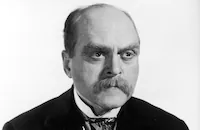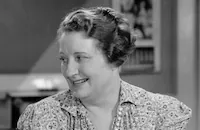Conflict

Brief Synopsis
Cast & Crew
Curtis Bernhardt
Humphrey Bogart
Alexis Smith
Sydney Greenstreet
Rose Hobart
Charles Drake
Film Details
Technical Specs

Synopsis
The seemingly perfect marriage of Kathryn and Richard Mason is the envy of their friends, but on the day of their fifth wedding anniversary, the couple quarrels bitterly over Richard's infatuation with Kathryn's younger sister, Evelyn Turner. Later, at a party in the Masons' honor, which is being given by psychologist Dr. Mark Hamilton, the discussion turns to the nature of psychology. Hamilton explains that a thought can be like a malignant disease and it is his job to help a patient get rid of that thought. He adds that love is often at the root of psychological problems. On the way home, Richard loses control of the car and crashes. Kathryn and Evelyn come through with only minor injuries, but Richard suffers a broken leg. Later, although x-rays show that Richard's leg is healed, he insists that he cannot stand on it. When the doctor recommends swimming to strengthen the injured leg, Kathryn and Richard plan a trip to the mountains. At the last minute, however, work keeps Richard in town, and he sends Kathryn on alone, promising to join her the following day. On the way, Kathryn stops at Hamilton's to ask him to look in on Richard, and he presents her with one of his prize roses. Several miles from the lodge, Kathryn's road is blocked by another car, and Richard steps out of the fog and strangles her. He then pushes her car over the cliff and rolls a pile of logs on top of it. That night, he establishes an alibi with a business associate and feigns worry when Kathryn does not arrive at the lodge on time. When Hamilton telephones as Kathryn asked, Richard tells him that she is missing and then calls the Highway Patrol and institutes a search. He also notifies Evelyn, who has been staying with her mother. The police are unable to find Kathryn, but a short time later, a hobo is spotted trying to pawn her distinctive cameo ring. At home, Richard smells Kathryn's perfume in their bedroom and discovers her safe key on his desk. Richard frantically calls the police when he finds Kathryn's wedding ring inside the safe. Richard's response leads Hamilton to suggest that he and Evelyn accompany him to the mountains for some fishing. Hamilton also invites Professor Norman Holdsworth, a young doctor who is interested in Evelyn, to join them in the mountains. After Evelyn turns down Norman's proposal, Richard tells her how he feels about her. Although Richard insists that she rejected Norman because she returns his love, Evelyn vehemently denies this. Richard returns to his office for a day, where a letter addressed in Kathryn's handwriting and containing a pawn ticket is waiting for him. He traces the ticket to a pawnshop and finds Kathryn's locket. When he brings the police to the pawnshop, however, the locket is no longer in the case, and the pawnbroker denies Richard's story. Then, Richard sees a woman he believes to be Kathryn and follows her to an apartment house before losing her. Richard visits Hamilton's office to ask his advice and is told that the psychologist can do nothing for him. Desperate, Richard drives back to the scene of the crime. The pile of logs is still on the car, so Richard climbs down the mountain, where Hamilton and the police are waiting. Hamilton explains that he knew Richard was lying when he said Kathryn was wearing a rose when she left the house, because Hamilton had given her the rose himself. The police found Kathryn's body the day after the murder, but because there was no proof of Richard's guilt, they agreed to stage Hamilton's trap and let Richard's own fears convict him.

Director

Curtis Bernhardt
Cast

Humphrey Bogart

Alexis Smith

Sydney Greenstreet

Rose Hobart

Charles Drake

Grant Mitchell
Pat O'moore

Ann Shoemaker
Frank Wilcox

James Flavin
Edwin Stanley
Mary Servoss
Doria Caron
Ray Hanson
Billy Wayne

Ralph Dunn
John Harmon
Bruce Bilson

Marjorie Hoshelle
Frances Morris
George Carleton
Oliver Prickett
Harlan Briggs
Wallis Clark

Jack Mower

Emmett Vogan
Crew
Al Alleborn
Roy Davidson
Elmer Decker
Leo F. Forbstein
Oliver S. Garretson
Merritt Gerstad
Frederick Hollander
Arthur T. Horman
William Jacobs
H. F. Koenekamp
Jerome Moross
Alfred Neumann
Orry-kelly
Robert Siodmak
Ted Smith
Clarence I. Steensen
Dwight Taylor
James Vincent
Jack L. Warner
David Weisbart
Perc Westmore

Videos
Movie Clip



Trailer
Hosted Intro
Film Details
Technical Specs

Articles
Conflict
By 1943 when production began on this picture (its release was held up for two years), Bogart had advanced from reliable second-stringer at the studio to major star, largely on the strength of his work in High Sierra (1941), The Maltese Falcon (1941), and Casablanca (1942). It was unusual, to say the least, for Warners to cast its rising star as a sinister and mentally disturbed killer riddled with weaknesses, rather than as an in-control tough guy - the type of character audiences were coming to expect of him. But producers must have felt there was something of value in such a career move because they pressed Bogart into the role against his wishes, threatening to keep him out of his longed-for next picture, Passage to Marseille (1944), until he completed this one. After an initial attempt to intimidate and alienate director Curtis Bernhardt, Bogart settled amiably into the part and gave one of his most interesting performances.
The star is helped greatly by the taut screenplay and the effective work of Bernhardt in such scenes as the wife's murder and the opening "eavesdropping" camera track into the house. Many film writers have observed in Conflict one of Hollywood's earliest examples of film noir with its romantic fatalism and the stylistic echoes of German Expressionist cinema. Both Bernhardt and Robert Siodmak (who originated the story and directed many of the top noir films of the 40s) were German born and started their careers in that country.
Conflict is also one of the first movie plots to depend heavily on the ideas and techniques of psychoanalysis. Bernhardt later claimed to have no particular interest in psychiatry, although at least three of his films deal extensively with the subject. But this movie doesn't seem to be a significant one in his estimation of his career. In fact, he said he had so little memory of it that when he saw it on TV in Italy years later, dubbed in Italian so he couldn't understand the dialogue, he had no idea what was happening. Someone in the building where Bernhardt was staying came up to his room asking how the film ended and the director couldn't tell him.
A few items of interest to connoisseurs of more arcane movie lore: Frederick Hollander (aka Friedrich Hollander), who composed this picture's score, is most frequently associated with Marlene Dietrich, having composed songs and scores for nine of her movies, including her signature tunes "Falling in Love Again" from The Blue Angel (1930) and "The Boys in the Backroom" from Destry Rides Again (1939). Rose Hobart, who plays the murdered wife here, starred in a rather obscure exotic adventure-romance called East of Borneo (1931). That movie was re-edited into a surrealistic short by artist Joseph Cornell in 1936 and given the actress's name as a title. Hobart's career was cut short by the Hollywood blacklist of the late 40s. Finally, two years after Conflict, Humphrey Bogart was once again a disturbed man plotting to kill his wife (Barbara Stanwyck) for the love of Alexis Smith in The Two Mrs. Carrolls (1947).
Director: Curtis Bernhardt
Producer: William Jacobs
Screenplay: Arthur T. Horman, Dwight Taylor; story by Robert Siodmak, Alfred Neumann
Cinematography: Merritt Gerstad
Editing: David Weisbart
Art Direction: Ted Smith
Original Music: Frederick Hollander
Cast: Humphrey Bogart (Richard Mason), Alexis Smith (Evelyn Turner), Sydney Greenstreet (Dr. Mark Hamilton), Rose Hobart (Katherine Mason).
BW-86m. Closed captioning.
by Rob Nixon

Conflict
Quotes
Trivia
Notes
The film's working title was The Pentacle. Press releases included in the file on the film at the AMPAS Library state that Eleanor Parker was originally cast as "Evelyn" and that Robert Shayne was to make his film debut in this film. Shayne, however, started in films in 1934. A June 10, 1943 Hollywood Reporter news item noted that Alexis Smith replaced Nancy Coleman in the role of "Evelyn." In a transcribed May 6, 1943 conversation between Humphrey Bogart and Jack L. Warner, which is reprinted in a modern source, Bogart made a vehement protest against appearing in the film because he disliked the script. Warner threatened the actor with suspension if he did not appear and, at a later time, Bogart agreed. According to the daily production reports on file at the USC Cinema-Television Library, Bogart was ordered to report to work on May 3, 1943 but did not. When production finally started on 15 Jun, Bogart was on the set. Conflict was the first of two films in which Bogart played a wife killer. In the second, The Two Mrs. Carrolls, a 1947 Warner Bros. film, Smith also played the "other woman."

Miscellaneous Notes
Released in United States June 15, 1945
Released in United States June 30, 1945
Released in United States on Video May 20, 1992
Released in United States Summer June 14, 1945
Completed shooting August 25, 1943.
The song "Tango of Love," used in the film, is uncredited.
Released in United States on Video May 20, 1992
Released in United States Summer June 14, 1945
Released in United States June 15, 1945 (Los Angeles)
Released in United States June 30, 1945















